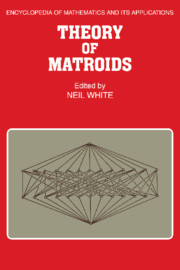Book contents
- Frontmatter
- Contents
- List of Contributors
- Series Editor's Statement
- Foreword
- Preface
- Chapter 1 Examples and Basic Concepts
- Chapter 2 Axiom Systems
- Chapter 3 Lattices
- Chapter 4 Basis-Exchange Properties
- Chapter 5 Orthogonality
- Chapter 6 Graphs and Series-Parallel Networks
- Chapter 7 Constructions
- Chapter 8 Strong Maps
- Chapter 9 Weak Maps
- Chapter 10 Semimodular Functions
- Appendix of Matroid Cryptomorphisms
- Index
- ENCYCLOPEDIA OF MATHEMATICS AND ITS APPLICATIONS
Chapter 8 - Strong Maps
Published online by Cambridge University Press: 05 May 2010
- Frontmatter
- Contents
- List of Contributors
- Series Editor's Statement
- Foreword
- Preface
- Chapter 1 Examples and Basic Concepts
- Chapter 2 Axiom Systems
- Chapter 3 Lattices
- Chapter 4 Basis-Exchange Properties
- Chapter 5 Orthogonality
- Chapter 6 Graphs and Series-Parallel Networks
- Chapter 7 Constructions
- Chapter 8 Strong Maps
- Chapter 9 Weak Maps
- Chapter 10 Semimodular Functions
- Appendix of Matroid Cryptomorphisms
- Index
- ENCYCLOPEDIA OF MATHEMATICS AND ITS APPLICATIONS
Summary
MINORS AND STRONG MAPS
What are the maps, or morphisms, in the category of matroids? As is usual for objects arising in combinatorial analysis and universal algebra, there is more than one reasonable answer. In this chapter and the next, two approaches and their relationship will be discussed.
The notion of morphism is dependent on the notion of subobject. A reasonable notion of subobject for the category of matroids is that of a minor. To define a minor, we first recall from Chapter 7 the operations of contraction and deletion. Let M be a matroid on the set S, and let U and V be subsets of S. The restriction of the matroid M to the set U is the matroid M(U) on the set U for which the rank of a subset A in U is simply its rank in M as a subset of S. We also say that the restricted matroid M(U) is obtained from M by deleting the elements in S – U from S, and we shall sometimes denote M(U) by M –(S – U). The contraction of M by the subset V is the matroid M/V on the set S – V whose rank function is as follows: For A ⊆ S – V, r(A) = rM(A ∪ V) – rM(V). Contractions and deletions commute in the sense that for any pair of disjoint subsets U and V, the matroids (M – U)/V and (M/V) – U are the same matroid on the set S – (U ∪ V).
- Type
- Chapter
- Information
- Theory of Matroids , pp. 224 - 253Publisher: Cambridge University PressPrint publication year: 1986
- 10
- Cited by

